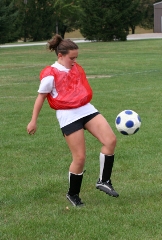Implementing a coach-led neuro-muscular warm-up for female high school soccer and baskteball players at predominantly low-income, inner city schools is an extremely cost-effective way to reduce the number of noncontact leg injuries, including ACL injuries, among an under-served, at-risk population, a new study finds.1
Coach-led neuro-muscular training combines progressive strengthening, balance, polymetric, and agility exercises with education on avoiding dynamic knee valgus, a position that increases ACL injury risk, and landing jumps with flexed hips and knees, which reduces ACL strain. Previous studies had shown that such training, either during preseason or as in-season warm up, reduced lower extremity injuries in adolescent female soccer and basketball athletes.
The Chicago study, however, is the first to demonstrate that high school coaches at mixed-ethnicity, predominantly low-income, urban high schools - where practice conditions are often erratic, and that lack athletic trainers and access to medical care for most athletes - can be trained to follow neuromuscular training programs, and that such training is a cost-effective injury prevention strategy, as the $1,280 total cost of training the 16 basketball coaches necessary to avoid 1 lower leg injury resulting in surgery is substantially less than the $17,000 to $25,000 estimated treatment cost for just one ACL injury treated surgically.
Recruited coaches at Chicago public high schools
Cynthia R. LaBella, M.D. and her colleagues at the Feinberg School of Medicine at Northwestern University in Chicago, asked 258 coaches from Chicago Public Schools to participate, randomly assigning 90 coaches either to the intervention group (those who instituted a 20-minute neuromuscular warm-up before every practice and an abbreviated version prior to each game) or a control group (those who maintained current warm-up procedures).
Coaches in the intervention group attended a two-hour training session led by the principal investigator and head athletic trainer two weeks prior to the start of the 2006-2007 season. During the session, coaches were instructed on how to implement a 20-minute neuromuscular warm-up before every practice and an abbreviated version prior to each game.
Key findings
Of 95 coaches randomized in the study, 90 (94.7 percent) participated, representing 36 of the 80 Chicago public high schools that offer girls' basketball or soccer programs, and included 755 athletes in the control group and 737 athletes in the intervention group. The data revealed that:
- The control group had 96 lower extremity injuries, compared to 50 lower extremity injuries in the intervention group.
- Thirteen control athletes and two intervention athletes each sustained two lower extremity injuries.
- All athletes with noncontact lower extremity injuries that required surgery were in the control group.
- Teams using the warm-up more frequently had lower rates of acute-onset lower extremity injuries, but this difference was not significant.
Low-cost prevention strategy
Additionally, the authors estimated that the cost of training for a group of 15 to 20 coaches was roughly $80 per coach, suggesting that this program can feasibly be implemented in predominantly low-income, urban populations, such as the one studied.
Intervention coaches reported using the prescribed warm-up before a mean (average) of 80 percent of practices, and only six of the 53 intervention coaches reported using the prescribed warm-up for less than 50 percent of practices. No control coaches were observed using any prescribed practices, and most omitted a warm-up or had athletes jog or warm-up by themselves.
Neuromuscular training: routine use urged
The incidence of ACL injury is much higher in the female athlete than in the male, with young female athletes up to eight times more likely than boys to tear their ACLs and more prone to non-contact ACL injuries. Although the precise reasons girls are at greater risk than boys are not clear, one theory holds that the way in which a female athletes lands after a jump plays a role, as females tend to land with their knees more hyperextended and somewhat knock-kneed, which theoretically places a great deal of tension on the ACL, leading to tears.
"A neuromuscular warm up probably 'trains' the female athletes how to jump and land with better biomechanics, thus putting less stress on the ACL resulting in a lower incidence of injury," said Victor Khabie, MD, FAAOS, FACS, of the Somers Orthopaedic and Sports Medicine Group, Chief, Department of Surgery, Co-Director of the Orthopedic and Spine Institute, and Chief of Sports Medicine at Northern Westchester Hospital in Mount Kisco, New York.
Because "ACL injuries in female basketball and soccer players are a major concern," said LaBella, "any intervention which can decrease the incidence of an ACL tear is extremely valuable." "Our findings suggest that neuromuscular training should be routine in girls' high school soccer and basketball," she said.
LaBella's recommendations were echoed by Khabie. "The study [shows] how a relatively inexpensive and readily available intervention (neuromuscular warm-up training) can significantly reduce the incidence of an ACL tear," he said, "More wide spread use of this warm up protocol should be considered by coaches and trainers working with female athletes to help prevent serious knee injuries."
1. LaBella CR, Huxford MR, Grissom J, et. al. Effect of Neuromuscular Warm-Up on Injuries in Female Soccer and Basketball Athletes in Urban Public High Schools. Arch Ped & Adolesc Med. 2011;165(11):1033-1040.
Posted November 7, 2011








